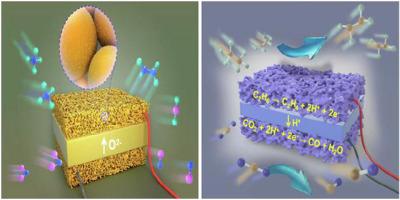Journal of Energy Chemistry ( IF 14.0 ) Pub Date : 2020-06-30 , DOI: 10.1016/j.jechem.2020.06.050 Lingting Ye , Kui Xie

|
Solid oxide electrolysis cells (SOECs) can convert electricity to chemicals with high efficiency at ~600–900 °C, and have attracted widespread attention in renewable energy conversion and storage. SOECs operate in the inverse mode of solid oxide fuel cells (SOFCs) and therefore inherit most of the advantages of SOFC materials and energy conversion processes. However, the external bias that drives the electrochemical process will strongly change the chemical environments in both in the cathode and anode, therefore necessitating careful reconsideration of key materials and electrocatalysis processes. More importantly, SOECs provide a unique advantage of electrothermal catalysis, especially in converting stable low-carbon alkanes such as methane to ethylene with high selectivity. Here, we review the state-of-the-art of SOEC research progress in electrothermal catalysis and key materials and provide a future perspective.
中文翻译:

固体氧化物电解槽中的高温电催化及关键材料
固态氧化物电解池(SOEC)可以在约600-900°C的温度下高效地将电能转化为化学物质,并在可再生能源的转化和存储中引起了广泛关注。SOEC以固态氧化物燃料电池(SOFC)的反向模式运行,因此继承了SOFC材料和能量转换过程的大部分优点。但是,驱动电化学过程的外部偏压将极大地改变阴极和阳极中的化学环境,因此需要仔细考虑关键材料和电催化过程。更重要的是,SOEC提供了电热催化的独特优势,特别是在稳定的低碳烷烃(例如甲烷)以高选择性转化为乙烯的过程中。这里,











































 京公网安备 11010802027423号
京公网安备 11010802027423号